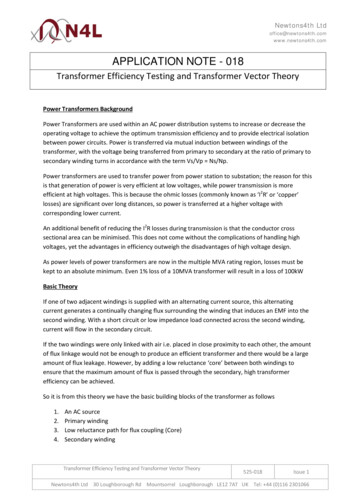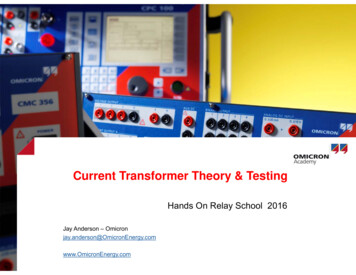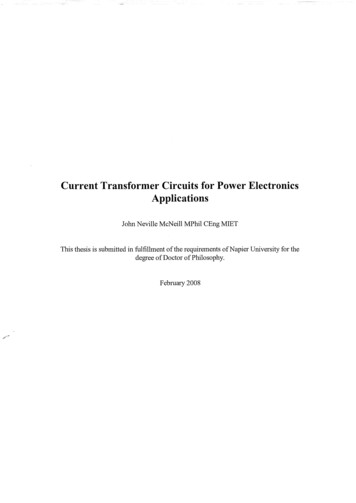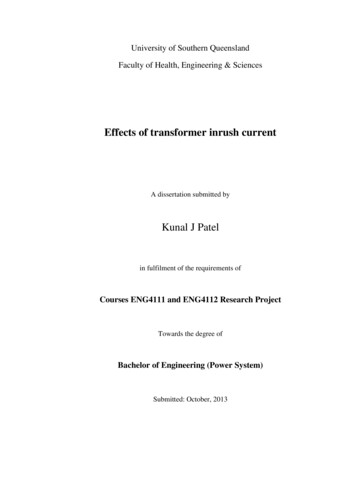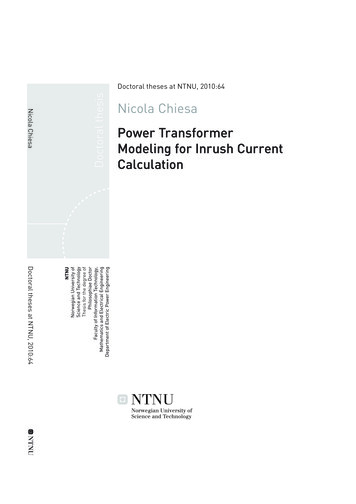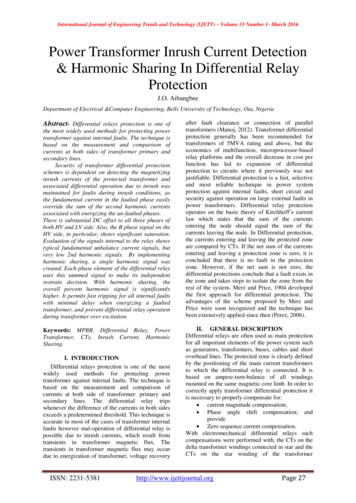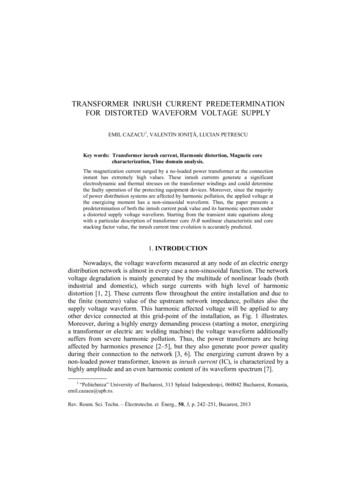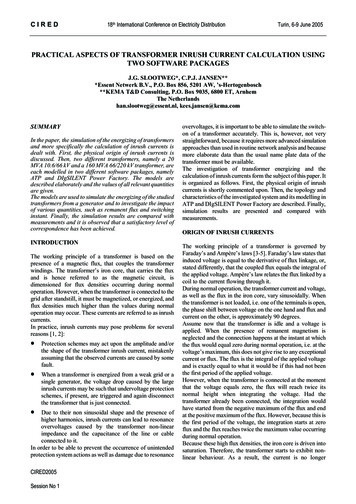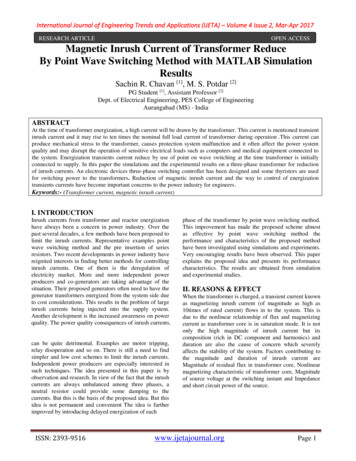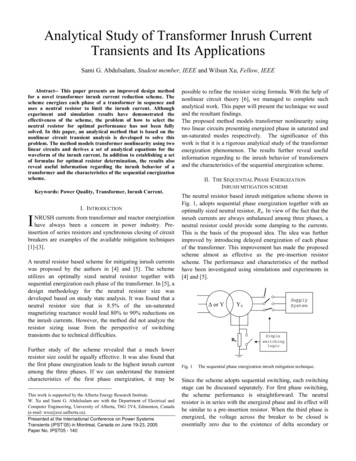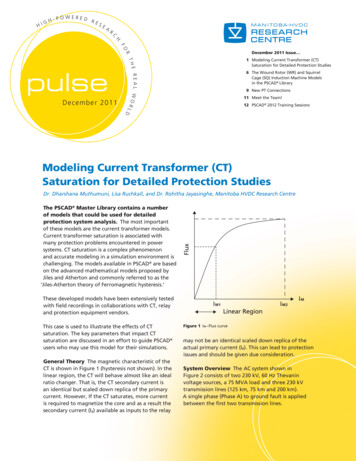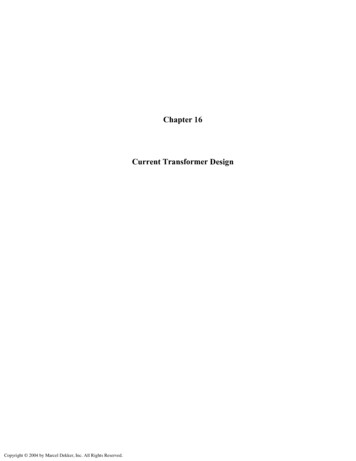
Transcription
Chapter 16Current Transformer DesignCopyright 2004 by Marcel Dekker, Inc. All Rights Reserved.
Table of Contents1. Introduction2. Analysis of the Input Current Component3. Unique to a Current Transformer4.Current Transformer Circuit Applications5. Current Transformer Design Example6.Design PerformanceCopyright 2004 by Marcel Dekker, Inc. All Rights Reserved.
IntroductionCurrent transformers are used to measure, or monitor, the current in the lead of an ac power circuit. Theyare very useful in high-power circuits, where the current is large, i.e., higher than the ratings of so-calledself-contained current meters. Other applications relate to overcurrent and undercurrent relaying for powercircuit protection, such as, in the power lead of an inverter or converter. Multiturn secondaries thenprovide a reduced current for detecting overcurrent, undercurrent, peak current, and average current, asshown in Figure 16-1.LoadFigure 16-1. Simple, Secondary AC Current Monitor.In current transformer designs, the core characteristics must be carefully selected because excitationcurrent, Ira, essentially subtracts from the metered current and effects the true ratio and phase angle of theoutput current.The simplified equivalent circuit of a current transformer, as shown in Figure 16-2, represents the importantelements of a current transformer, where the ratio of primary to secondary turns is:N« —KNPCopyright 2004 by Marcel Dekker, Inc. All Rights Reserved.[turnsratio] [16-1]
Figure 16-2. Simplified, Equivalent Circuit for a Current Transformer.Analysis of the Input Current ComponentA better understanding of the current transformer behavior may be achieved by considering the appliedinput current to the primary winding, in terms of various components. Only the ampere-turn component,linNp, drives the magnetic flux around the core. The ampere -turn, ImNp, provides the core loss. Thesecondary ampere -turns, ISNP, balance the remainder of the primary ampere -turns.The exciting current, Im, in Figure 16-2, determines the maximum accuracy that can be achieved with acurrent transformer. Exciting current, Im, may be defined as the portion of the primary current that satisfiesthe hysteresis and eddy current losses of the core. If the values of Lc and Re- in Figure 16-2, are too lowbecause the permeability of the core material is low and the core loss is high, only a part of the current,(Ip/n), will flow in the output load resistor, RO. The relationship of the exciting current, Im, to the loadcurrent, I0, is shown in Figure 1 6-3 .The exciting current is equal to:QAxN,[amps] [IM]where H is the magnetizing force and material dependent, and MPL is the Magnetic Path Length.linO-to-lr»to-VNAARSFigure 16-3. Input Current-Output Current Relationship.Copyright 2004 by Marcel Dekker, Inc. All Rights Reserved.
The input current is comprised of two components: exciting current, Im, and the load current, I0.Then:I2m lrn-I20, [amps][16-4], [amps]Im Iin[16-5]The above equation has shown graphically in Figure 16-4, that the higher the exciting current, Im or coreloss, the larger the error. The magnetizing impedance, Rg, determines accuracy, because it shunts part ofthe input current, !;„, away from the primary and thus, produces an error, as shown in Figure 16-4. Corematerial with the lowest value of H achieves the highest accuracy.Figure 16-4. Input Current I in Phase Relationship Diagram.Unique to a Current TransformerThe current transformer function is different than that of a voltage transformer. A current transformeroperates with a set primary current and will try to output a constant current to the load, independent of theload. The current transformer will operate into either a short circuit or a resistive load until the voltageinduced is enough to saturate the core or cause voltage breakdown. For this reason a current transformershould never operate into an open circuit, as a voltage transformer should never operate into a short circuit.The primary current of a current transformer is not dependent of the secondary load current. The current isreally injected into the primary by an external load current, Ijn. If the load current, I0, on the currenttransformer is removed from the secondary winding, while the external load current, Ijn, is still applied, theflux in the core will rise to a high level, because there is not an opposing current in the secondary windingto prevent this. A very high voltage will appear across the secondary. A current transformer, like any othertransformer, must satisfy the amp-turn equation:I.Copyright 2004 by Marcel Dekker, Inc. All Rights Reserved.N,
The secondary load, RO, secondary winding resistance, Rs, and secondary load current, I0, determine theinduced voltage of the current transformer.VS I0(RS R0],[volts] [16-7]If the secondary is designed for dc, then the diode drop must be taken into account.Vs I0(Rs R0) Vd, [volts][16-8]Simple form:Vs V0 V d , [volts][16-9]The current ratio will set the turns ratio. The secondary, RO load will determine the secondary voltage, Vs.The engineer would use Equation 16-10, to select the required core cross-section, Ac. It is now up to theengineer to pick a core material that would provide the highest permeability at the operating flux density,Bac.4I!n(R, R2KfBacfNsThe design requirements would dictate choosing a core material and operating flux density, Bac, that wouldresult in values of, Lc and Re, as shown in Figure 16-2, values which would be large enough to reduce thecurrent flowing in these elements to satisfy the ratio and phase requirements.The inductance is calculated from the equation:L -—- -L '-, y[henrys]JLMPL[16-11]Jis the equivalent core loss, (shunt), resistance. The current is, in phase, with the voltage.Re , [ohms][16-12]Where:Hf-D RS R0n[16-13]And:nRS R0[16-14]Then:Ip nlsCopyright 2004 by Marcel Dekker, Inc. All Rights Reserved.[16-15]
Or:IpNp IsNs[16-16]Except for relatively low-accuracy industrial types, current transformers are wound on toroidal cores,which virtually eliminate errors due to leakage inductance.Some errors may be compensated for byadjusting the number of secondary turns.Current Transformer Circuit ApplicationsTypical current transformer applications are shown in Figures 16-5 through 16-8.OFigure 16-5. Current Transformer, T2, used to Monitor, Ql and Q2, Drain Current.Tl-OI)v-OFigure 16-6. Current Transformer, Tl, used to Monitor Line Current.Copyright 2004 by Marcel Dekker, Inc. All Rights Reserved.
RIOCurrentSenseFigure 16-7. Current Transformer, Tl, is used as a Level Detector.Figure 16-8. Current Transformer, Tl, is used for regenerative drive.Copyright 2004 by Marcel Dekker, Inc. All Rights Reserved. 5VRef
Current Transformer Design ExampleThe following information is the design specification for a current transformer, as shown in Figure 16-9.CR1-4Figure 16-9. Current Monitoring Transformer with dc Output.1. Primary1 turn2. Input current, I;n0 - 5 amps3. Output voltage, V00 - 5 volts4. Output load resistance, R,500 ohms5. Operating frequency, f (square wave)2500 hertz6. Operating flux density, Bac0.2 tesla7. Core loss less than3% (error)8. Diode drop, Vd1 volt9. Magnetic materialSupermalloy 2 mil10. Waveform factor, Kf4.0Step 1. Calculate the secondary current, Is./, —,[amps]5/Ts ' , r[amps]n500 0.01, [amps]Step 2. Calculate the secondary turns, Ns./ /v,[turns](0.01)Ns 500,Copyright 2004 by Marcel Dekker, Inc. All Rights Reserved.[turns][turns]
Step 3. Calculate the secondary voltage, Vs.Vs V0 2Vd,[volts]Vs 5.0 2(1.0),[volts]Vs 7.0, [volts]Step 4. Calculate the required core iron cross-section, Ac, using Faraday's Equation.(Kf}BacfNs, [cm2](7.0)(l0 4 )A c AI(4.0)(0.2)(2500)(500)'Ac 0.070,r2L[cm2]Step 5. Select a 2mil tape, toroidal core from Chapter 3 with an iron cross-section, Ac, closest to the valuecalculated.Core number . 52000Manufacturer . MagneticsMagnetic material . 2mil SilconMagnetic path length, MPL . 4.99 cmCore weight, Wtfc . 3.3 gramsCopper weight, W(cu . 8.1 gramsMean length turn, MLT . 2.7 cmIron area, AC.0.086 cm2Window area, Wa . 0.851 cm"Area product, A.0.0732 cm4Core geometry, K . 0.000938 cm5Surface area, A( . 20.6 cm2Step 6. Calculate the effective window area, W a(eff) . A typical value for, S3, is 0.75, as shown in Chapter 4.Copyright 2004 by Marcel Dekker, Inc. All Rights Reserved.Wa( ff) WttS,,[cm2]Wa(eff] 0.638,[ c m2 ]
Step 7. Calculate the secondary window area, Wa(Sec)."* "* 20.6382[ fl(scc) 0.319, [cm2]Step 8. Calculate the wire area, A w , with insulation , using a fill factor, S2 of 0.6.(0319X 6)(500)/4W 0.000383,[cm2]Step 9. Select a wire area, Aw, with insulation from Wire Table in Chapter 4 for an equivalent AWG wiresize. The rule is that when the calculated wire area does not fall within 10% of those listed, in Wire Table,then, the next smaller size should be selected.AWG No. 334, 0.0003662, [cm2]Step 10. Calculate the secondary winding resistance, Rs using the Wire Table in Chapter 4, for uQ/cm; andStep 5 for the MLT.Rs MLT(7V,.)[ — ](lO 6 ),Rs (2.7)(500)(6748)(lO 6 ),Rs 9.ll,[ohms][ohms][ohms]Step 11. Calculate the secondary output power, P0.P0 I,(V0 2Vd),[watts]P 0 (0.01)(5.0 2(1.0)), [watts]P0 0.070,Copyright 2004 by Marcel Dekker, Inc. All Rights Reserved.[watts]
Step 12. Calculate the acceptable core loss, Pfe.„ ( core loss 'Pfe 0.0021, [watts]Step 13. Calculate the effective core weight, Wtfe(eff). Select the core weight correction factor, Kw, inChapter 2, for Supermalloy.»W) (3-3)0.148), [grams]Wtfe(eff) 3.19,[grams]Step 14. Calculate the allowable core loss, Pfe, in milliwatts per gram, mW/g./ , ,\mW/g — 10 J,mW/g —mW/g 0.554,[milliwatts per gram]- (103),[milliwatts per gram][milliwatts per gram]Step 15. Calculate the new flux density using the new core iron, cross-section, Ac.(7.0)(l0 4 )ac"(4.0)(0.086)(2500)(500)'Bac 0.162,[tesla]Step 16. Calculate the core loss, Pfe, in milliwatts per gram, mW/g.mW/g 0.000179(/) 48) (Bac )(2 '5) , [milliwatts per gram]mW/g 0.000179(2500) 48) (0.162)'2 '5) , [milliwatts per gram]mW/g 0.382,Copyright 2004 by Marcel Dekker, Inc. All Rights Reserved.[milliwatts per gram]
Step 17. Calculate the core loss, Pfe, in watts. — .VJ-5P /e 3.79(0.382)(lO- 3 ), [watts]P/e 0.00145,[watts]Step 18. Calculate the induced core error in, %.Core loss induced error - -(100), [%]oCore loss induced error '00145 (100),Core loss induced error 2.07,[%][%]Design PerformanceA current transformer was built and the data recorded in Table 16-1. It was plotted in Figure 16-10, withan error of 3.4 %. The secondary winding resistance was 6.5 ohms.Table 16-1Current Transformer Electrical .806volts3.4883.7914.3394.8315.6065.04.0 -3.0IU 2.0i.oI1.0I2.03.0Output Voltage, VQ (volts)4.05.0Figure 16-10. Current Transformer, Input Current versus Output Voltage.Copyright 2004 by Marcel Dekker, Inc. All Rights Reserved.
The current transformer function is different than that of a voltage transformer. A current transformer operates with a set primary current and will try to output a constant current to the load, independent of the load. The current transformer will operate into either a short circuit or a

